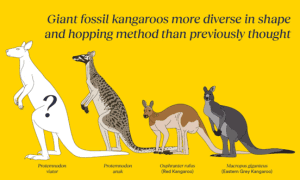TAG: GS 3: ECOLOGY AND ENVIRONMENT
THE CONTEXT: The discovery of three new species of giant kangaroos – Protemnodon viator, Protemnodon mamkurra, and Protemnodon dawsonae – marks a significant milestone in our understanding of Australia’s prehistoric fauna.
EXPLANATION:
- The vast and diverse continent of Australia has been home to a myriad of unique and fascinating creatures throughout its geological history.
- Among these ancient inhabitants were the giant kangaroos, or Protemnodon, which once roamed the land in sizes far surpassing their modern counterparts.
- These formidable creatures, which inhabited the continent from 5 million to 40,000 years ago, contribute to the rich tapestry of ancient life that once thrived in the region.
- With the aid of advanced imaging techniques, including photographs and 3D scans of 900 specimens from major museums worldwide, researchers meticulously analyzed skeletal remains to distinguish between these distinct species.

Morphological Variations and Adaptations:
- One of the most intriguing findings of the study is the remarkable morphological diversity observed among the giant kangaroo species.
- Beyond mere differences in size, researchers uncovered distinct variations in locomotion, with some species employing a quadrupedal gait akin to modern kangaroos, while others exhibited a unique combination of bounding on four legs and hopping on two.
- This adaptive flexibility likely enabled these megafauna to thrive in diverse habitats ranging from the arid expanses of central Australia to the lush forests of Tasmania and Papua New Guinea.
Insights into Evolutionary History:
- The classification of these newfound species offers a crucial framework for elucidating the evolutionary trajectory of giant kangaroos and their responses to environmental change over millennia.
- By reconstructing their evolutionary history, researchers can unravel the intricate interplay between ecological dynamics and evolutionary forces that shaped the diversity of Australia’s ancient megafauna.
- Moreover, the study provides valuable insights into the evolutionary relationships between these extinct giants and their extant relatives, shedding light on the broader evolutionary patterns within the marsupial lineage.
Human Impact and Extinction:
- Despite their impressive adaptations and ecological resilience, the giant kangaroos ultimately succumbed to the forces of extinction.
- While their close relatives, such as the grey kangaroo and wallaroo, endured, the exact reasons for their demise remain elusive.
- However, mounting evidence suggests that rapid environmental changes induced by human activities, such as habitat alteration and hunting pressures, may have played a significant role in their extinction.
- The study underscores the importance of understanding past extinction events to inform conservation efforts and mitigate the ongoing biodiversity crisis.
Significance of the Research:
- The groundbreaking research not only enriches our knowledge of Australia’s ancient fauna but also highlights the importance of interdisciplinary approaches in paleontological studies.
- By harnessing cutting-edge technologies and collaborating across international borders, scientists have unlocked new insights into the lives of these enigmatic megafauna.
- Moreover, the study underscores the need for continued exploration and preservation of Earth’s rich fossil heritage, providing a window into the deep-time history of life on our planet.
Kangaroos:
- Kangaroos are large marsupials with powerful hind legs, large feet adapted for leaping, a long muscular tail for balance, and a small head.
- They possess a marsupium (pouch) for joey development.
- Native Habitat: Indigenous to Australia and New Guinea, with tree-kangaroos also living in tropical rainforests of New Guinea and far northeastern Queensland.
- Population Estimate (2019):8 million within commercial harvest areas of Australia.
- Adaptations: Specialized teeth for grazing, polyphyodonty for tooth replacement, and adaptation to land clearing better than smaller macropods.
- Cultural Significance: A symbol of Australia, appearing on the nation’s coat of arms, currency, and as logos for organizations like Qantas and the Royal Australian Air Force.
- Utilization: Hunted for meat, leather hides, and to protect grazing land. Kangaroo meat is considered healthier due to low fat levels.

